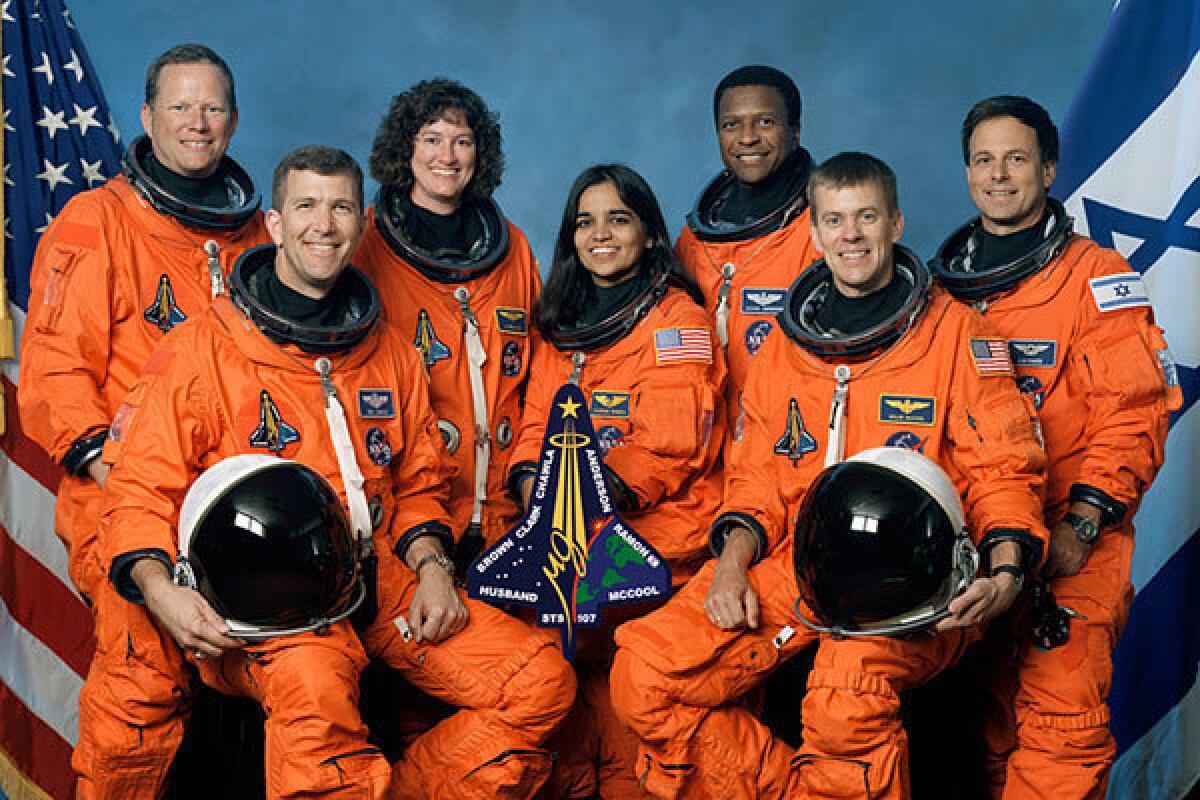A somber 10-year anniversary for space shuttle Columbia

- Share via
Ten years ago Friday, the shuttle Columbia crumbled to Earth after 16 days in the heavens.
As the shuttle passed over Texas en route to a routine landing in Florida, its left wing failed to withstand the heat of reentry. The craft burst into more than 83,000 pieces, showering the land below for hundreds of miles.
The seven astronauts aboard were killed: Air Force Col. Rick Husband, 45, the crew commander; Navy Cmdr. William McCool, 41, the pilot; Air Force Lt. Col. Michael Anderson, 43, payload commander; Navy Capt. Laurel Clark, 41; Navy Capt. David Brown, 46; Israeli Air Force Col. Ilan Ramon, 48, Israel’s first astronaut; and Kalpana Chawla, 41, a civilian.
Full coverage: The Columbia Disaster
To honor their memory -- and the loss of previous crews from the shuttle Challenger in 1986 and Apollo 1 in 1967 -- NASA has scheduled memorials Friday for its annual Day of Remembrance at Arlington National Cemetery and at the Space Mirror Memorial in the Kennedy Space Center Visitor Complex in Florida.
That service, hosted by the Astronauts Memorial Foundation, was slated to begin at 10 a.m. Eastern and to feature several speakers, including Evelyn Husband-Thompson, the widow of Columbia commander Husband.
The massive investigation became a damning public trial for NASA’s aging, sclerotic bureaucracy.
Full coverage: The Columbia Disaster
A six-part series by then-Los Angeles Times staff writer Robert Lee Hotz -- who would become a Pulitzer finalist for the stories -- retraced the investigation, which revealed the organizational and scientific neglect that had befallen the world’s premier space program:
“The Columbia accident investigation was the most exhaustive scientific inquest ever undertaken. Suspicion led down a hundred blind alleys. Investigators quarreled. Mission insiders tried to control the probe. Outsiders railed about secrecy. The investigators mustered the most sophisticated techniques that science could devise — X-ray scanners, neutron beam machines, hypersonic wind tunnels. They also used red food coloring, a bicycle pump, a hobby-shop hacksaw and a steam iron. They conducted some tests in classified military laboratories, others in the nearest kitchen sink. In arcane debates about trapped-gas analysis, radar cross sections and spatter metallurgy, they stalked answers to wrenching questions of guilt, shame and responsibility. Every imperfection they found revealed a human face. All that they discovered reinforced what Hallock learned by dropping his No. 2 pencil. The space shuttles are by design unsafe.”
Hotz was referring to James Hallock, a member of the Columbia Accident Investigation Board, who had used a No. 2 pencil and some basic math to figure out what the public didn’t know yet: that the reinforced carbon panels on the shuttle’s wings had been designed to survive the heat of reentry but not debris the shuttle might encounter during its own takeoff.
Just 81.9 seconds after liftoff, a piece of insulation foam flaked off the shuttle’s 15-story external fuel tank and punched a hole in the leading edge of Columbia’s left wing. Foam had always fallen off fuel tanks during liftoff, but this was the largest piece to hit a shuttle. Some observers spotted a possible strike and started to raise questions that NASA officials did not want to answer:
“While Columbia was still in orbit, shuttle managers had silenced internal critics who warned of possible foam damage. They dismissed the concerns for lack of proof, then ensured that no proof could become available. The managers rejected three requests that intelligence agency observatories and imaging satellites be used to inspect the orbiter. Over the years, shuttle managers had treated each additional debris strike not as evidence of failure that required immediate correction, but as proof that the shuttle could safely survive impacts that violated its design specifications. Three months before Columbia’s last flight, foam debris had severely damaged the shuttle Atlantis. Program managers met to decide what corrective action they should take. Rather than suspend all flights while engineers explored ways to fix the problem — as official procedure previously dictated — they decided Columbia should proceed without delay. They refused to classify the incident as an official ‘in-flight anomaly.’ Instead, they adopted a formal ‘flight rationale’ stating that it was safe to fly. A generation of NASA managers had turned engineering on its head, viewing evidence of failure as signs of success. For Columbia’s last flight, all the paperwork was in order.”
On reentry, the puncture wound created by the foam became the entry vent that turned Columbia’s left wing into a furnace. Facing the intense atmospheric heat generated by reentry, the wing melted from the inside and shredded away. Searchers found pieces of the shuttle across Texas and into Louisiana.
Columbia, which had flown 27 earlier missions, tumbled apart at speeds much greater than the speed of sound.
Full coverage: The Columbia Disaster
The Columbia disaster came 17 years after the shuttle Challenger exploded shortly after liftoff on Jan. 28, 1986, killing seven astronauts. Challenger’s demise was traced to a humble O-ring that couldn’t expand properly during a Florida cold snap.
Challenger came 19 years and a day after the spacecraft Apollo 1 caught fire during a ground test on Jan. 27, 1967, killing three astronauts.
More to Read
Sign up for Essential California
The most important California stories and recommendations in your inbox every morning.
You may occasionally receive promotional content from the Los Angeles Times.











